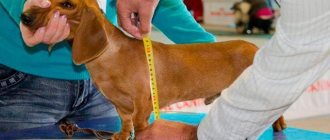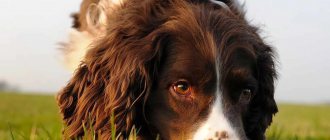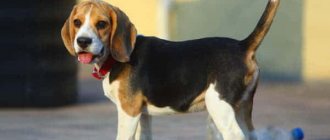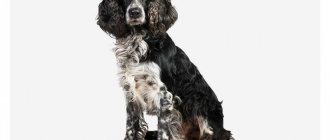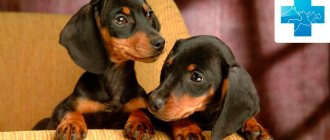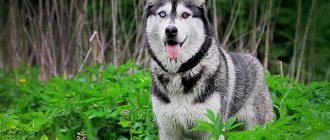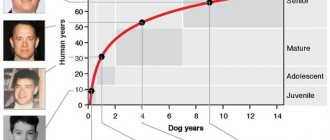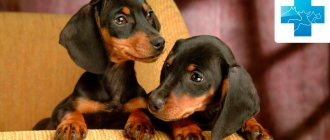Becoming the happy owner of a cheerful and active dachshund puppy, his owner must already realize that the pet will someday begin to grow old, and then the time will come to part with him.
Fortunately, Dachshunds are in good health and, if properly cared for, can live quite a long time.
But what can a dachshund owner do to ensure that his dog lives as long as possible?
And how to care for an elderly pet to extend its days as much as possible?
How old do dachshunds grow?
Babies are born weighing 200-300 grams. and in the first months of life, puppies are very dependent on their mother. If you are offered a puppy under 1.5 months of age, check with your veterinarian to see if the baby is healthy, how he has been eating and where his mother is.
The longer the puppies are not taken away from their mother, the better. Feeding with mother's milk in the first months of life is important for the formation of a healthy individual, which affects life expectancy. At the age of one month, baby dachshunds approach the bowl, then feeding and smooth weaning from milk begin.
Puppies enter a new family at 1.5-2 months and grow up to a year, but the dog will be fully formed at 15 months, the main thing during the growth period is to feed the puppy correctly and not to overeat.
To properly shape your pet, regularly monitor its weight; deviations from the norm will lead to the development of diseases in a fragile body, and you can forget about long years of life together. For a dachshund, weight control is the main condition for a long existence in our world.
Ways to extend the life of a pet
How many years his dog will live depends to a large extent on the care and attention of the owner. And although the most significant role in the life expectancy of dachshunds is played by their heredity, dog owners can also do a lot to extend the life of their pets as much as possible.
Proper nutrition
Its well-being and state of health depend on what a dachshund eats. With natural feeding, the dog’s diet should contain at least 30% meat products. If the dog is a working dog, then the share of meat in its daily menu should be increased to 50%. Along with meat, the pet must receive raw or boiled vegetables and cereals from rice, buckwheat, and rolled oats. In addition, it is useful to give your dog fermented milk products without sugar and fruit additives, with the exception of sour cream and full-fat (more than 2.5% fat) natural yogurt.
If your dachshund eats ready-made food, then choose a premium, super-premium or holistic class diet for it.
If the dog is prone to obesity or has other health problems that require a special diet, then feed him the dietary food recommended by the veterinarian.
Quality maintenance and care
Soft beds are not suitable for dachshunds. They often have back problems due to which these dogs need to sleep on hard bedding. Caring for their coat, with the exception of the wire-haired variety that requires trimming, is quite simple. You need to brush your pet regularly and bathe it from time to time.
the dog’s eyes with cotton pads, after moistening them in a special product that can be purchased at a pet pharmacy. The ears must be cleaned periodically with a cotton swab. its claws down on its own during walks. But if she doesn’t walk much on asphalt or, for example, gravel, then they should be shortened with a nail clipper as they grow.
To keep your pet's teeth and gums in order, you need to take care of purchasing special treats or chewing toys for him.
Normal puppy weight chart
| Age, months | Weight, kg |
| 2 months | 2,5 – 3 |
| 3 months | 3 – 4 |
| 4 months | 4 – 5,5 |
| 5 months | 5,5 – 7 |
| 6 months | 7 – 8,5 |
| 12 months | 8,5 – 12 |
An adult standard breed by 12 months should weigh no more than 12 kg, with a height at the withers of 35-40 cm, the weight of a dwarf dachshund is 5-7 kg and a height of 30-35 cm, a rabbit is much smaller with a height of 30 cm the dog weighs 3.5- 4 kg.
Routine veterinarian visit, vaccinations
You need to visit a veterinarian regularly, especially if your dog has chronic diseases. All emerging diseases must be treated on time and not delayed. It is also important to carry out all necessary vaccinations in a timely manner, which will help protect your pet’s body from diseases such as:
- plague,
- parainfluenza,
- leptospirosis,
- hepatitis,
- rabies,
- enteritis.
Note! It is also necessary to treat your pet for worms and other parasites. For this purpose, medications are used that protect the dog from fleas, lice and ticks. Harmful insects are often carriers of quite serious diseases that can cause the premature death of a pet.
What affects life expectancy
While raising their dog with love and caring for it, the owners do not take into account that there are causes of early mortality that do not depend on us. But the determining factors of the disease can be foreseen and the development of diseases can be prevented.
Factors influencing the life expectancy of a dachshund:
- Genetics. Different breeds are predisposed to certain diseases, which can manifest throughout their lives.
- Illnesses of parents. The mother passes on most of her genes to the puppies; if she had diseases, there is a high probability that she will pass them on to her children.
- Lifestyle. Dachshunds are energetic and active by nature; daily walks and proper exercise are necessary to maintain vitality in the pet.
- Proper nutrition. The lifespan of a pet depends on its diet, which includes all the necessary products in the right quantities. Dachshunds are prone to obesity.
- Childbirth. Dachshund girls live a little longer than boys. But constant uncontrolled births of puppies harm the health of the mother.
- Stress. The adult becomes vulnerable to a stressful situation, like all domestic animals, such as the loss of an owner, which can lead to the death of the animal.
Take care and love your pet, the dachshund is very attached to the owner, any harsh word can lead to the development of the disease and undesirable consequences.
Signs of an aging dog
Despite their longevity, dogs begin to age at the age of five. Gradually, the teeth wear down, the color becomes paler, and the first gray hairs appear. Adult pets are less playful and active; they prefer to rest rather than endlessly move, as before.
Internal changes are also taking place. Very often, a dachshund 13 years old and older is completely deaf, and therefore does not respond to the owner’s commands. Problems arise with the musculoskeletal system - intervertebral discs become displaced, hip joints become inflamed and hernias form.
How to find out the age of a dachshund
The main indicator of a dog's age is its teeth. At the age of three months, a puppy grows all its milk teeth, 28 of them, and from 3-8 months they are replaced with molars. By one year the dog has 42 white and clean teeth, this is an indicator that the puppy has matured.
If it is necessary to determine the age of an adult, pay attention to the wear of the fangs: by the age of five, the teeth begin to become dull; at the age of six, the color changes from white to more yellow at the base of the fangs. At the age of 10-12 years, the pet begins to lose its first teeth.
Examine the dog; at the age of seven, the coat begins to change: it becomes coarser and less dense, the color becomes lighter. This does not mean that the pet is sick, just that the body begins to age. Gray hair appears on the face. The dog's eyes become dull, the pupils become a little cloudy.
Age-related changes in a pet will be less pronounced if it lives in good conditions, eats properly and walks for four hours every day; this is the optimal load for an adult dachshund.
How to extend the life of a pet?
To extend your dachshund's life, you need to take proper care of it from the first day the puppy arrives in your home.
Good maintenance and care, a balanced diet, adherence to a schedule of vaccinations , deworming and treatment for external parasites - this is the guarantee that a dachshund puppy will grow into a healthy adult dog and live a long time .
It is absolutely necessary to teach a pet of this breed at least basic commands: this will help minimize the risk of accidents while walking with your pet.
But teaching commands alone is not enough: the dachshund needs to be educated, and this process must continue throughout the dog’s life. For example, you need to wean your dog from running after moving vehicles, rushing at other dogs, or picking up all sorts of nasty things from the ground.
After all, all this often causes injury or poisoning, and fights with stray dogs, in addition, are fraught with the risk that the pet will contract rabies or, for example, distemper.
If a dachshund takes part in breeding , then you need to be responsible for its use as a sire, and provide quality care during estrus .
Too frequent matings are harmful for dogs of both sexes; they exhaust their bodies and can significantly shorten their lives.
Comparison table with human years
Dachshunds begin aging at the age of eight, but much depends on the breed variety. Dwarf dachshunds are active and energetic until the age of 12; the standard dachshund is a medium-sized breed and begins to be lazy on walks at 8-10 years of age.
Scientists have proven that the smaller the breed, the faster it matures, but the slower it ages. Large dogs take longer to mature, but age several years earlier.
How long does a dachshund live by human standards?
| Dachshund age, years | Breed type | Person's age |
| 1 year | Standard | 10,5 |
| 1 year | Dwarf | 9 |
| 2 years | Standard | 15 |
| 2 years | Dwarf | 15 |
| 3 years | Standard | 20,5 |
| 3 years | Dwarf | 19,5 |
Next, for each year of the pet’s life, you need to add 4.5 years for the dwarf type and 5.5 for the standard variety of the breed.
The age of a dog by human standards
It is well known that dachshunds are long-lived. Many people want to understand how to correlate their age with the years of a person’s life. This is done in different ways, using interesting schemes. There is no scientific basis for them. Research by biologists suggests that a dog develops unevenly - the first two years are rapid, and then the process slows down. So, a taxi driver of one year is a teenager of fifteen years old, and a dachshund of two years is a young man of 24.
The dog-to-human age table looks like this:
| Dachshund age (years) | Person's age (years) |
| 1 | 15 |
| 2 | 24 |
| 3 | 28 |
| 4 | 32 |
| 5 | 36 |
| 6 | 40 |
| 7 | 44 |
| 8 | 48 |
| 9 | 52 |
| 10 | 56 |
| 11 | 60 |
| 12 | 64 |
| 13 | 68 |
| 14 | 72 |
| 15 | 76 |
| 16 | 80 |
How long do dachshund boys and girls live?
On average, girls live 2-3 years longer than males. This depends on the dog’s temperament; boys more often become the initiators of fights and constantly get involved in “dog relationships”, where they can get injured.
Girls are more flexible and careful, especially during pregnancy, but they are more likely to develop diseases of the genitourinary system. Proper planning of puppies will protect the bitch from developing diseases.
The main parameter of life expectancy is the dog’s participation in hunting: if the pet lives on the couch and walks according to a schedule, then with proper care it will live for many years. A hunting dog is subject to stress and regular overuse, which can shorten its life.
The average lifespan of the rabbit variety is 13 years; dwarf varieties live 14-15 years. The biological age of a dog depends on the lifestyle of the owner and his pet.
Life expectancy of dogs of different sexes
Life expectancy is generally independent of the sex of the animal. It is believed that males may live a little longer because females can often have problems with the reproductive system that arise with age. Unfortunately, boys can also have problems with the genitourinary system, which can shorten their lives.
Healthy girls can easily give birth and live the same time and even a little longer than cables. Females are more cautious and have a calmer character. Dwarf and miniature dachshunds live an order of magnitude shorter.
Diseases and common causes of death of dachshunds
Many breeds are predisposed to certain diseases that impair performance and motor functions and, if not treated promptly, lead to the death of the animal. But there are many other dangers from which only its owner can save a pet.
Dachshund diseases that can lead to death:
- Spinal defect. The disease can be congenital or appear at 5-7 years of age. Displaced vertebrae pinch the spinal cord, which leads to paralysis of the hind legs, as a result of which the dog moves little. These are obesity and heart failure.
- Osteoporosis. It appears at one year of age and leads to inflammation of the joints. Due to pain, the dog becomes inactive, which leads to heart disease and diabetes - these diseases are difficult to treat.
- Poisoning. With proper training, the dog's intelligence will tell you what to eat and what not. But while the puppy is growing up, he can try everything. It is necessary to protect the dog from household chemicals and keep an eye on the street so that it does not catch a poisoned rodent. This is the most common cause of poisoning in dachshunds.
- Viral diseases. Deadly diseases of dogs are enteritis, rabies and plague, which can be carried by other animals or humans. It is necessary to vaccinate the puppy against viral infections and observe the incubation period after vaccination.
All diseases can be prevented; the owner needs to take the dog to the veterinarian at the slightest ailment of the animal, who will make a diagnosis, prescribe medicine and give recommendations on what care the pet needs for a long life.
Quality maintenance and care
Dachshunds are prone to back diseases, and therefore soft mattresses and beds are not suitable for them: the pet’s sleeping place must be quite hard.
NOTE!
Caring for dogs of this breed is not difficult: smooth-haired and long-haired dachshunds are regularly brushed, and during the molting period this procedure is done more often.
Bathe your pet as needed.
Wire-haired dogs are trimmed in accordance with the standard, and if the dog is a show dog, it is better if it is groomed by a professional groomer.
You cannot replace trimming with a haircut: this will deteriorate the texture and quality of the coat .
Dachshund eyes are cleaned with a cotton swab dipped in warm water or a special liquid to clean them. Ears should be inspected regularly, and if dirty, cleaned with cotton swabs.
Representatives of this breed usually clean their teeth themselves, so the owner can only make sure that the pet always has special treats or chewing toys.
If the claws grow excessively, it is recommended to shorten them using a nail clipper .
How to increase the lifespan of dachshunds
The main rule for extending the life of a pet is nutrition, vaccination and care. The dachshund is a genetically healthy and active dog that is adapted to long walks; give them at least four hours a day.
How to extend your pet's life:
- Vaccinations. Follow the vaccination schedule throughout your life, this guarantees immunity to all viral diseases.
- Nutrition. You need to feed your pet balanced dry food or specially prepared food, this will relieve your pet from allergic reactions and digestive problems. A dachshund needs daily: rice, buckwheat or oatmeal, vegetables and fruits, milk, cheese, cottage cheese and lean meat at least 30% of the total amount of food.
- Vitamins. Vitamin treats are useful for a dog at any age, especially if it is over seven years old. If your pet’s coat does not recover well after shedding and loses thickness and shine, this is a sign of a lack of macro and microelements and vitamins in the body.
- Getting rid of parasites. Inspect the animal once a week; with thick fur, it is difficult to notice fleas right away, so regular checks will help you quickly take action. Twice a year it is necessary to carry out prevention against worms, especially if the pet eats raw meat. Inspect your dog's ears for mites, which can cause epilepsy.
- Regular walks. The dachshund is born to move; it is better to take your pet outside at the same time and at least twice a day, preferably with games and proper exercise. If the dog is not accustomed to harsh conditions, in cold weather it is necessary to wear overalls or a blouse, this will protect against colds.
- Control of matings. If the dog is not planned as a breeder, it is better to sterilize the animal. Constant mating undermines the health of both females and males. When breeding a breed, do not allow your pet to mate more than once a year, so that there is time for the body to recover.
Pay attention to the slightest change in your pet's character and mood.
The dog cannot tell that something hurts; if the pet has become bored and lethargic, contact the veterinarian.
Diseases
To maintain the health necessary to prolong longevity, it is important to monitor pathological changes in the dachshund’s body.
Signs of a disorder in the spine are restless behavior of a dog that has difficulty lying down. The hind limbs may fail. It is advisable to seek help immediately.
After an x-ray, examination and examination, conservative treatment is prescribed, including physiotherapy, medications, and massage. In complicated cases, surgery is required.
Osteoporosis occurs in representatives of the breed if there is not enough vitamin D in the diet or the pet rarely goes for walks.
Symptoms:
- spreading paws;
- motor dysfunction.
Urgent treatment with the inclusion of vitamins and minerals is necessary.
Acanthosis may occur, affecting the skin, which becomes covered with pigmentation. The fur falls out and wrinkles form. Special ointments are used for treatment. Ear pathologies require the use of drops prescribed by a veterinarian.
Expert opinion
Anna Abramenko
An avid dog lover. Experience in veterinary medicine since 2009.
Ask a Question
Long-haired dachshunds may exhibit idiopathic epilepsy with loss of consciousness and seizures. To reduce the frequency of attacks, sedatives are indicated.
Eye pathologies that are typical especially for short-haired varieties are treated with medications or surgery is prescribed.
Briefly about the main thing
- Living in the same house with a dachshund, we can definitely say that with proper care, she will delight you and your children with her presence for many years.
- The dachshund is not demanding when it comes to nutrition, but has an increased appetite; it is necessary to control the pet’s weight.
- The lifespan of a dog depends on proper care and preventive measures.
- The breed requires regular exercise and vigorous long walks.
- The dog is not prone to diseases if vaccinated in a timely manner.
- To prevent breed diseases of the spine and joints, it is necessary to regularly visit a veterinarian.
Genetic characteristics of dachshunds
Hereditary predisposition to certain types of pathologies affects the physical condition of animals. And knowing the characteristic qualities of a pet allows you to organize competent care.
If we consider dachshunds, there is a genetic tendency to rapid weight gain and obesity. These dogs have a reduced life expectancy.
Expert opinion
Anna Abramenko
An avid dog lover. Experience in veterinary medicine since 2009.
Ask a Question
Peculiarities of the breed include the sensitivity of the spine to jumping. Do not allow your dachshund to go down the stairs to avoid causing serious injury.
Dogs may suffer from periodic ear inflammation. As you get older, glaucoma or cataracts develop. A tendency to urinary tract diseases has been revealed.
Older animals develop problems with their gums and teeth. The average full life span for girls is longer compared to males, since boys are often exposed to nervousness.
Varieties, description of the breed with photos
The breed is sometimes also called the German Dachshund and Duckhound. Wire-haired dachshunds are divided into 3 varieties based on size. In addition to the standard one, there are the wire-haired rabbit dachshund, which is classified as a hunting dog, and the mini wire-haired dachshund, which is more suitable for the characteristics of decorative companion dogs.
Dogs intended for burrow hunting have a peculiar appearance with greatly shortened paws, a strong muscular body and an elongated muzzle. Stamina and considerable physical strength allow dachshunds to withstand fights with larger animals such as foxes and badgers.
- Head. The shape is wedge-shaped, pointed. The beard gives it the appearance of a rectangle. The back of the head is well developed. The jaws are strong. The brow ridges do not protrude, but are intensely emphasized by the hair.
- Ears. Large, triangular in shape, hanging down at the sides. The end of the ear is rounded. Capable of active movement.
- Lips and mouth. Lips are medium size, dry. The mouth is deep, having a full set of teeth, which are distinguished by their strength and closure density.
- Eyes. Oval shape. The iris is a rich brown color. Sometimes there are individuals with amber eyes. Blue iris color is allowed only in dachshunds with blue merle coloring.
- Nose. It has a straight back that tapers slightly towards the lobe. The color can be black or brown. The nostrils are well developed.
- Body. Massive, elongated shape. The neck has a well-developed scruff. The withers are distinguished by their muscularity, this property is especially pronounced in males. The chest is oval, elongated, well developed, but not very wide. It is lowered below the elbow joints. The line of the back decreases from the withers to the croup. The loin is elongated. The croup is muscular. The belly is not saggy - its line is smooth.
- Paws. Short, muscular, with well-developed joints. Located parallel to each other. The elbows are pressed tightly to the chest. The wrists are placed under the body, which creates the effect of crooked paws. The hind legs are widely spaced, slightly longer than the front legs.
- Tail. Curved in the shape of a sickle or straight. Set slightly below the back line. When excited, the dog picks it up and carries it freely the rest of the time. According to the breed standard, he should not stand upright or lie down on his back.
Minor external deviations from the standard cause a decrease in exhibition ratings. An animal with pronounced defects is not allowed for exhibitions and breeding.
Size and weight
The weight and height of the wire-haired dachshund depend on the breed type. Individuals weighing more than 10 kg, even with excellent physical shape and ideal build, are rated low at exhibitions or are not allowed to participate in them, since they are not considered as a working dog due to their large dimensions.
- Standard size dogs, which is the most common, are up to 35 cm tall at the withers and weigh from 7 to 9 kg. Males are slightly larger than females.
- Rabbit variety. Grows from 30 to 33 cm at the withers. Weight allowed from 3 to 5 kg. The influence of gender on weight and size can also be seen.
- Decorative mini variety. It grows no higher than 30 cm and gains weight no more than 3 kg. Minimum permissible weight 2.5 kg. Excessively small dogs, like overly large ones, are rated poorly at shows or are not allowed to participate in them, as this is a significant deviation from the breed standard.
Color and coat type
The dog's coat is straight, hard, and has a thick undercoat. Its length in most cases does not exceed 3 cm. On the muzzle, the fur forms a mustache, beard and well-defined eyebrows. Its characteristics fully comply with working requirements: the coat reliably protects the dog from cold, water, dirt, as well as injuries during fights in a hole with an animal, while at the same time it is easy to care for.
The breed standard allows for various colors: solid, two-color, spotted, marbled, brindle. Colors available include pepper and salt, wild boar, hare, brown and grey. The red tone of the coat can be either light or dark. Less common is a light fawn color. The most complex decorative colors are welcomed in mini dachshunds.
Popular dachshund colors
There are 3 types of dachshunds, which differ in coat type:
- Dachshund longhaired, shiny satin;
- The dachshund is wire-haired, with a fairly short beard;
- A short-haired dachshund with a smooth coat.
Moreover, these 3 types of wool are available in several shades of colors.
Therefore they distinguish:
- Dachshunds with a solid color, such as red, yellow or orange;
- Two-colored dogs, for example, with a black and fiery color;
- Dark dogs.
White color is excluded from the breed standard because the dachshund can go unnoticed in its favorite environment - the forest. Among the shades of the dwarf dachshund's coat are red, yellow-red and yellow. All these varieties of flowers can be with or without a black tint. On the other hand, most Standard Dachshund owners prefer the solid color, while red is more popular than chartreuse and yellow. The muzzle and nails of this dog breed are usually black in color, sometimes reddish brown, depending on the color of their coat.
There are black or brown dachshunds with fiery markings. They may be rusty brown or yellow in color. The least common fire types are the most popular. In addition, the character of such a dachshund is ideal for hunters. Strong and resilient, this dachshund is a true dog hunter. She may carry dirt in her fur and this is completely normal. To maintain the color of her coat, you need to groom her regularly and methodically, but not too much.
The brindle dachshund's undercoat is always dark black, red or gray. You may see irregularly shaped gray or beige spots
The color of the brindle dachshund is usually red or yellow, with dark brindle, but no matter what variety the dachshund's coat has, it is important to get used to grooming it as soon as possible. This is also part of raising a dachshund.
General characteristics and health
The dwarf dachshund is a very lively dog, intellectually developed and capable of learning. She will happily help her owner in all matters, participate in morning runs and picnics.
The dachshund is also an excellent hunter, and it will not be difficult for her to catch up or bring game. It seems that such an energetic dog should live a long time, but it’s not that simple. Due to her short stature, her genes contain problems with joints, especially the hip.
One careless jump can provoke displacement of the vertebrae, cause pain in the animal, or become the beginning of a sluggish disease process. Dachshunds often suffer from a hernia, and treatment for this disease is difficult.
It follows from this that when choosing a puppy, you need to look at the pedigree, illnesses, etc., how the dog and its parents were kept, and whether there were any injuries. What illnesses did your parents already have, and what diet should they follow?
On average, dachshunds live up to 12 years, but for a dog to live longer, it needs to be fed and walked correctly. All these recommendations should be given by the nursery, or ask about it yourself, you can use our article, which describes how to care for your dachshund so that it lives with you for many years.
You need to walk your dachshund regularly, training it in the ability to climb into holes, this way you protect the dog from displacement of the vertebrae, regular warm-up in special holes is what the dachshund needs
But at the same time, it is important that the dog does not climb trees - this exceptional habit of dachshunds will not bring anything good
Her training must take place exclusively on the ground. The same applies to jumping at home - from the sofa to the floor and vice versa, this should not be done, especially at a young age. Climbing the stairs back and forth should not harm the dog, since these jumps are not sudden. A leisurely ascent and descent is useful, but only once a day - do not overexert the dog, such training is quite a difficult task for a dachshund.
Skin problems
The elongated body suggests a non-standard structure of the spine. Therefore, the dachshund's back is always supported by moderate physical activity.
Experts advise against going up and down stairs for up to 7-8 months, jumping from great heights, and sitting in an upright position.
The main and common problem of dachshunds is discopathy. The vertebrae may move out of place, and the cartilage may stretch or become thinner. Then the dog shows the following signs:
- Anxiety;
- Painful sensations with light pressure on the back;
- Hind limb failure;
- Involuntary urination.
In case of severe symptoms of the disease, surgical intervention cannot be avoided. The diagnosis is made on the basis of studies, including x-rays.
Dachshund puppies suffer from swimmer's syndrome. Already in the first weeks after birth, this disease manifests itself as follows:
- It is difficult for the puppy to roll over;
- Limbs come apart when trying to stand on them;
- Flattening of the chest.
Sometimes swimmer's syndrome goes away on its own, but in severe cases the dog is euthanized. Swimming in warm water and walking with support additionally helps to cope with a protracted illness.
The most common of these in dachshunds and all dogs are fleas and demodicosis. The first parasites are removed by drops and washing. All products are selected according to the age and weight of the dog.
Be sure to carry out prevention every 3 months with drops on the withers, sprays against fleas and ticks. Shampoos for dogs are used medicinal.
Demodicosis in chronic and generalized form is treated under the supervision of a doctor. In the acute phase, powerful drugs that destroy subcutaneous mites help.
However, they can negatively affect the liver and other organs, so maintenance medications are prescribed.
- Local and severe baldness;
- Thickening of the skin and the appearance of folds in these places;
- Unpleasant odor;
- Change in skin color.
Acanthosis nigricans takes a long time to treat and most often becomes chronic. A diet that alleviates the course of the disease is also important.
We invite you to familiarize yourself with: Prehistoric animals and their way of life, how protocetes lived
Allergic reactions do occur in dachshunds, but not all of them. They get rid of the problem by choosing a safe diet. Potential allergens that try to exclude at the first signs (itching, redness, baldness, swelling):
- Chicken;
- Vegetables;
- Corn;
- Cereals.
If the dog is feeling unwell, they are given medications to eliminate allergy symptoms. However, to identify the cause, you need to look at the reaction to certain foods. Allergens are excluded from the dachshund menu forever.
Dog care
Caring for a pet is not very difficult; it consists of examining:
- Teeth and ears, especially after walking outside, because... a puppy can quickly catch a disease, in particular otitis media. Every month you should clean your dog’s ears with cotton swabs and prevent hypothermia and water from getting into his ears.
- Fur check for fleas. You need to periodically go over the entire body with a soft brush or a special furminator and bathe the animal 2 times a week with the addition of shampoo or conditioner.
- Kogotkov. They should be cut promptly so that they do not cling to anything.
- Examine the hind legs due to the tendency of this breed to various pathologies of the spine and the development of incorrect posture. This must be done for up to 9 months, until the dachshund acquires the status of an adult dog.
We must not forget about timely vaccinations. The first is given at 2 months, the second - after 2-3 weeks, the third - after a month and the fourth - at 8 months, it is the most serious and is done for rabies. It should be installed when changing teeth to permanent ones.
Dachshunds are quite energetic and playful dogs, and they have a long neck. Therefore, it is better to purchase a round synthetic collar if you have smooth wool, or in the form of a chain for a leash if you have fairly long and hard fur.
Today, the small dachshund with the palm of your hand is in fashion. You need to get used to wearing her clothes from the age of 1 month. The breed is quite capricious and will not tolerate strange outfits and will begin to actively resist. Of course, you need to protect your pet from the cold, but clothes should not be tight or tight. The main thing is that the dachshund does not strain its spine and does not jump from heights, which must be constantly monitored.
The main purpose of a dog is hunting. But today it is difficult to choose a purebred baby with similar skills from birth. It is best to buy from a breeder, making sure that it is a purebred dachshund. It is imperative to check the documents for the dog, as well as study the pedigrees of its parents. It must be based on FCI and RKF standards. It is advisable for the puppy to have a brand on its ear or part of its belly. The body should be tightly built and moderately well-fed. The eyes are exclusively brown in color, but gray and blue colors are already attributed to marriage, mestizos.
Dwarf dachshund breeds with a life expectancy of up to 15 years are interesting. But they suffer from human diseases more often than other breeds, namely influenza, chickenpox, eye cataracts, bronchitis and even diabetes.
It is extremely important to protect your pet and be sure to get up-to-date vaccinations. Otherwise, complications can lead to the rapid death of the pet.
After vaccination, it is advisable to exclude your pet from contact with street animals for 2-3 weeks in order to avoid infection with helminthic infestations and fleas.
How to care?
Caring for a puppy involves taking care of its health. This includes proper feeding, timely deworming, and timely vaccinations.
Walks are a must, especially with such an active dog as a dachshund.
Raising a dog should be handled by one person, it is advisable to immediately make it clear who is boss in the house. Rules of behavior are taught as early as possible and strictly adhered to, without making any concessions. Violence cannot be used as punishment.
You can express your dissatisfaction with the dog’s behavior by temporarily not paying attention to it; dachshunds are smart, they will understand everything:
- The puppy should have its own toys, clean warm bedding, and a place to feed.
- The pet's nails are trimmed as needed.
- Wipe the eyes with a warm, damp cloth.
- It is better to clean your ears by instilling a special lotion. It will contribute to the accumulation of dirt on the inside of the ear, from where it can be easily removed with a napkin.
- There are special brushes and toothpastes for teeth.
- The wool is wiped with a terry towel or a soft brush.
- Wash puppies if necessary and only with water without chemicals.
Tips for choosing a puppy
Choosing a puppy is a responsible undertaking on which your future peace of mind depends. Before this, it is advised to decide on the function that the pet will perform: decorative, companionship or working? Depending on this, a nursery is selected, where buyers look closely at the parents of the future pet.
After giving birth, the bitch feeds the puppies, then they are switched to food, undergo medical examinations, and receive vaccinations. First visits are allowed. At this stage, they usually consult a breeder or dog handler (the cost of the service is low or is included in the price of dachshund puppies). This person can tell you how to choose a puppy without defects, and identify the shortcomings of the dachshund you are looking for. For example, the puppy's tail should be straight, without ridges; the bite is correct.
A small dachshund should be moderately well-fed and playful. A lively reaction is welcome, but it is not required, since some character traits appear early (such as shyness, slight fearfulness, and so on). It is advised to choose a dog based on your feelings, because temperamental pets will “command” the owner.
There are defects that appear as the animal grows: incomplete change in coat color, the appearance of double incisors, and the formation of whitish spots. Some of them are unacceptable and are severely punished by judges at exhibitions.
After birth, dachshunds have dewclaws removed, if they are present in an adult puppy - this is a reason to think about the integrity of the breeder.
In general, choosing a dachshund is no different from purchasing a dog of another breed. Carefully monitor the puppies’ reaction and behavior; try to choose the one who will touch your heart the most.
